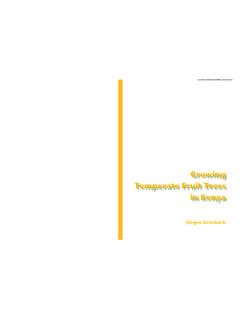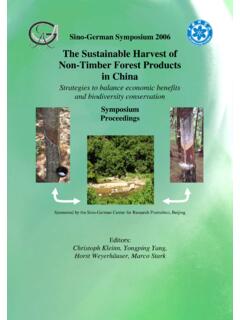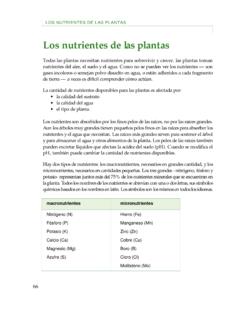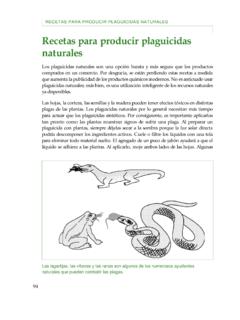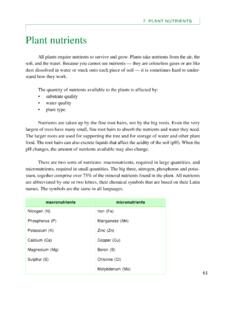Transcription of Cocoa Growing Countries - World Agroforestry Centre
1 Cocoa powder andchocolate are made fromthe dried seeds that arefound in pods on the cacaotree. In the 18th centurythe Swedish botanist,Carolus Linnaeus, renamedthe Cocoa tree giving it theGreek name TheobromaCacao, now its officialbotanical name, whichliterally means 'food ofthe Gods.' Although a native of theAmazon basin and othertropical areas of South andCentral America, where wild varieties still grow in the forests, the Cocoa Growing area has extended to theCaribbean and beyond. Different types of Cocoa are selected for cultivation in the various Growing areas.
2 Most of the World 's Cocoa is grown in a narrow belt 10 degrees either side of the Equator because the treesgrow well in humid tropical climates with regular rains and a short dry season. Even temperatures between 21and 23 degrees centigrade, with a fairly constant rainfall of 1,000 to 2,500 mm per year, are needed withouthot dry winds and Countries now grow Cocoa but the main producers are - West Africa - Ghana which grows some of the best quality Cocoa in the World , Nigeria and Cote D'Ivoire South America - Brazil and Ecuador Asia - Malaysia and Indonesia, where Cocoa is a relatively new crop, are becoming increasingly important Growing areas.
3 Cocoa was first planted in Ghana, now a major producer, in 1879 and asin the rest of West Africa, Cocoa is grown almost entirely on smallhold-ings where the whole family works together. Cocoa farming is a small,unsophisticated business as the current planting patterns of Cocoa treesmake mechanisation impractical. In Asia, public and private plantations have been developed as well asthe small AND CHOCOLATEC ocoa Growing CountriesMain Cocoa Growing Countries Drawing of Cocoa are three broad types of Cocoa FORASTEROand CRILLO plus TRINITARIO which is a hybrid of Forastero and Crillo.
4 Within these types are several varieties. FORASTERO, which now forms the greater part of all Cocoa grown, is hardy andvigorous producing beans with the strongest flavour. AMELONADO is the Forasterovariety most widely grown in West Africa and Brazil. It has a smooth yellow podwith 30 or more pale to deep purple beans. CRILLO with its mild or weak chocolate flavour is grown in Indonesia, Central andSouth America. Crillo trees are not as hardy and they produce softer pods which arered in colour, containing 20-30 white, ivory or very pale purple beans.
5 TRINITARIO plants are not found in the wild as they are cultivated hybrids of theother two types. Trinitario Cocoa trees are grown mainly in the Caribbean area butalso in Cameroon and Papua New Guinea. The mostly hard pods are variable incolour and they contain 30 or more beans of variable colour but white beans are rare. Cocoa trees resemble English apple trees, seldom reaching more than metres (25feet) high and they are carefully pruned so that pods can be more easily harvestedTo flourish they need to be shaded from direct sun and wind particularly in the earlystages of growth.
6 Two methods are used to establish Cocoa trees: Young trees are interspersed with new permanent or temporary shade trees such as coconut, plantains and bananas, following the clear-felling of the forest. In Asia where large plantations have been developed, Cocoa trees and coconut trees are planted together and both crops are harvested commercially. Alternatively forest trees are thinned out and the Cocoa trees are planted between established trees. Cocoa trees begin to bear fruit when they are 3-4 years old. The pink and white flowers, then the pods growstraight out of the trunk and main branches which is most unusual.
7 Like most tropical plants, flowers are presentthroughout the year but appear in abundance before the rain starts. Only a small proportion of all the flowersdevelop into fruit over a period of about five months. Each tree will yield 20-30 pods per year andthe peak time for harvesting is betweenSeptember and December in West Africa. The pods are hard and melon shaped, between15-20cm long and each weighing about 450geach. When the pods are ripe they changefrom green to yellow, red or orange. Each podcontains 20-40 seeds which when dried arethe Cocoa beans of takes the whole year's crop from one tree tomake 450gms of chocolate.
8 Cocoa AND CHOCOLATET ypes of CocoaCocoa TreesPicking Cocoa podsCocoa PodsThe harvesting of the pods is very labour intensive and on the West African small-holdings the wholefamily, together with friends and neighbours help out. Ripe pods are gathered every few weeks during thepeak season. Workers cut the high pods from the trees with large knives attached to poles, taking care not to damagenearby flowers or women of the family collect the pods in large baskets which they carry on their heads to be piled upready for splitting. The pods are split open by hand and the seeds or beans, which are covered with a sweet white pulp ormucilage, are removed ready to undergo the two part curing process - fermentation followed by drying.
9 Thisprepares the beans for market and is the first stage in the development of the delicious chocolate flavour. Methods of fermentation vary considerably from country to country but basically there are two methods -HEAPand the HEAP method is used on the farms in West Africa. Wet Cocoa beans, surrounded by thepulp, are piled on banana or plantain leaves which are spread out in a circle on the ground. More leaves areput on top to cover the heap and it is left for 5-6 days, turning to ensure even fermentation. Cocoa is alsofermented in baskets lined and covered with leaves - a method used in Nigeria.
10 Cocoa AND CHOCOLATEH arvesting Ripe Pods And Curing The Cocoa BeansSplitting open a Cocoa PodA pile of Cocoa Pods Cocoa AND CHOCOLATEH arvesting Ripe Pods And Curing The Cocoa Beans fermentation the pulp and astringency of the beans are removed as the sugar in the pulp turns toalcohol and vinegar-like liquids, which drain away and the true chocolate flavour starts to develop. When fermentation is complete the wet mass of beans is dried, traditionally by being spread in thesun on mats. In the West Indies, Latin America and in Malaysia the BOXmethod is used in the plantations while on small farms thetraditional heap method is still used.

